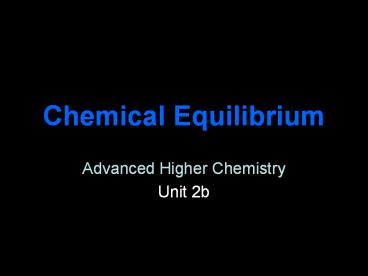Chemical Equilibrium PowerPoint PPT Presentation
Title: Chemical Equilibrium
1
Chemical Equilibrium
- Advanced Higher Chemistry
- Unit 2b
2
Revision
- Dynamic
- But to observe you would see no change
- Rate of forward reaction rate of reverse
reaction - Concentrations of reactants and products are
constant, but not (necessarily) equal
3
2Hl(g) H2(g) I2(g)
To which side does the equilibrium lie? How
would the graph differ if you started with H2 and
I2?
4
Calculating compositions
- To determine equilibrium composition of a
mixture, you need equilibrium amount of only ONE
of the species - Example
- CO(g) 3H2(g) CH4(g)
H2O(g) - You place 1.000 mol CO and 3.000 mol H2 in a
reaction vessel at 1200 K and allow the reaction
to come to equilibrium. The mixture is found to
contain 0.387 mol H2O. What is the molar
composition of the equilibrium mixture?
5
Calculation strategy
- You have starting amounts
- These will change over time
- They will remain constant at equilibrium
Amount (mol) CO 3H2 CH4 H2O
Starting Change Equilibrium 1.000 -x 1.000-x 3.000 -3x 3.000-3x 0 x x 0 x x 0.387
Therefore 0.613 mol CO, 1.839 mol H2, 0.387 mol
CH4, 0.387 mol H2O
6
Practice
- 1. You place 1.50 mol of dinitrogen trioxide into
a flask, where it decomposes at 25ºC and 1.00
atm - N2O3(g) NO2(g) NO(g)
- What is the composition of the reaction
mixture at equilibrium if it contains 0.45 mol of
nitrogen dioxide?
2. Nitric oxide, NO, reacts with bromine to give
nitrosyl bromide, NOBr 2NO(g) Br2(g)
2NOBr(g) A sample of 0.0655 mol NO with
0.0328 mol Br2 gives an equilibrium mixture
containing 0.0389 mol NOBr. What is the
composition of the equilibrium mixture?
7
The Equilibrium Constant, Kc
- For the reaction
- aA bB cC dD
- The value of the equilibrium constant is constant
for a particular reaction at a given temperature,
whatever the initial starting concentrations
8
Practice
- Write the equilibrium constant expression
for - The synthesis of ammonia by the Haber process
- The catalytic hydration of methane
9
Obtaining values for Kc
- Consider the reaction
- CO(g) 3H2(g) CH4(g) H2O(g)
- The equilibrium composition is
- 0.613 mol CO, 1.839 mol H2, 0.387 mol CH4, 0.387
mol H2O - The volume of the reaction vessel is 10.00 l.
- So the equilibrium concentration of CO is
0.613/10 0.0613 - What is the value of the equilibrium constant?
10
Practice
- Suppose for the same reaction the equilibrium
compositions in a 10 l vessel are - 1.522 mol CO, 1.566 mol H2, 0.478 mol CH4, 0.478
mol H2O - What is the vale of Kc?
11
Homo- / Heterogeneous Equilibria
- Consider the reaction
- 3Fe(s) 4H2O(g) Fe3O4(s) 4H2(g)
- Is this hetero- or homogeneous?
- For heterogeneous equilibria, pure solids and
liquids are omitted from the Kc - Write an expression for Kc for the above reaction
- This means that equilibrium is not affected by
amounts of these substances
12
The Equilibrium Constant, Kp
- For the reaction
- CO(g) 3H2(g) CH4(g)
H2O(g) - The equilibrium constant can be expressed in
terms of partial pressures
In general, for a particular reaction the value
of Kp will be different from Kc
13
Interpretation of K
- Does a large K mean that reactants or products
are favoured? - CH4(g) 2O2(g) CO2(g) 2H2O(g)
- Kc 1 x 10140 at 25ºC
- N2(g) O2(g) 2NO(g)
- Kc 4.6 x 10-31 at 25ºC
- If K is around 1, neither reactants or products
are favoured
14
Changing the reaction conditions
- Conditions can be changed to maximise product
- Concentration adding reactants, removing
products - Pressure change the volume of the vessel
- Temperture
- NOT a catalyst
15
Concentration change
- Example
- CO(g) 3H2(g) CH4(g) H2O(g)
- If cooled, water can be condensed and removed
Moles Moles Moles Moles
Stage of process CO H2 CH4 H2O
Original mixture 0.613 1.839 0.387 0.387
After removing water (before equilibrium readjusts) 0.613 1.839 0.387 0
Equilibrium re-established 0.491 1.473 0.509 0.122
Assuming a 1 l vessel, what is Kc for the
original equilibrium and for the re-established
equilibrium?
16
Pressure change
- How can you change the pressure of a system?
- What is meant by partial pressure?
17
Pressure change
Changing the volume of a reactant container
changes the concentration of gaseous reactants
and therefore their partial pressures Equilibrium
position will therefore move The value of Kc or
Kp does NOT change Changing pressure by adding
more of an inert gas has no effect of the
equilibrium position - No effect on partial
pressures
18
Temperature change
- Like concentration and pressure, temperature
affects the position of equilibrium - Unlike concentration and pressure, temperature,
temperature does affect the size of the
equilibrium constant - Consider the following data
Temperature (K) Kc
298 800 1000 1200 4.9 x 1027 1.38 x 105 2.54 x 102 3.92
Is this reaction exothermic or endothermic?
19
Summary
- K is temperature dependant, but is unaffected by
changes in concentrations or partial pressures
Change Equilibrium position Value of K
Concentration Pressure Temperature Catalyst Changes Changes Changes No change No change No change Changes No change

